I'll never forget the day I discovered Filipino Chicken Binakol during a rainy afternoon in Aklan. While sheltering from a sudden downpour at an Aklanon's house, I watched in amazement as she transformed simple ingredients into what would become my favorite comfort soup.
The aroma of lemongrass and ginger filled her tiny kitchen as she explained how her Lola used to cook this in bamboo stems during family gatherings. Unlike the tinola I grew up with in Manila, this version's coconut-infused broth was a revelation: light yet rich, familiar yet uniquely different.
Now whenever my kids are feeling under the weather or when Manila's rain starts pouring, this soup is my go-to recipe. The combination of native chicken slowly simmered in coconut water, with tender young coconut meat and aromatics, creates such a heartwarming dish that even my pickiest eater asks for seconds.
This traditional Binakol Na Manok recipe is about to become your family's new favorite, too.
Jump to:
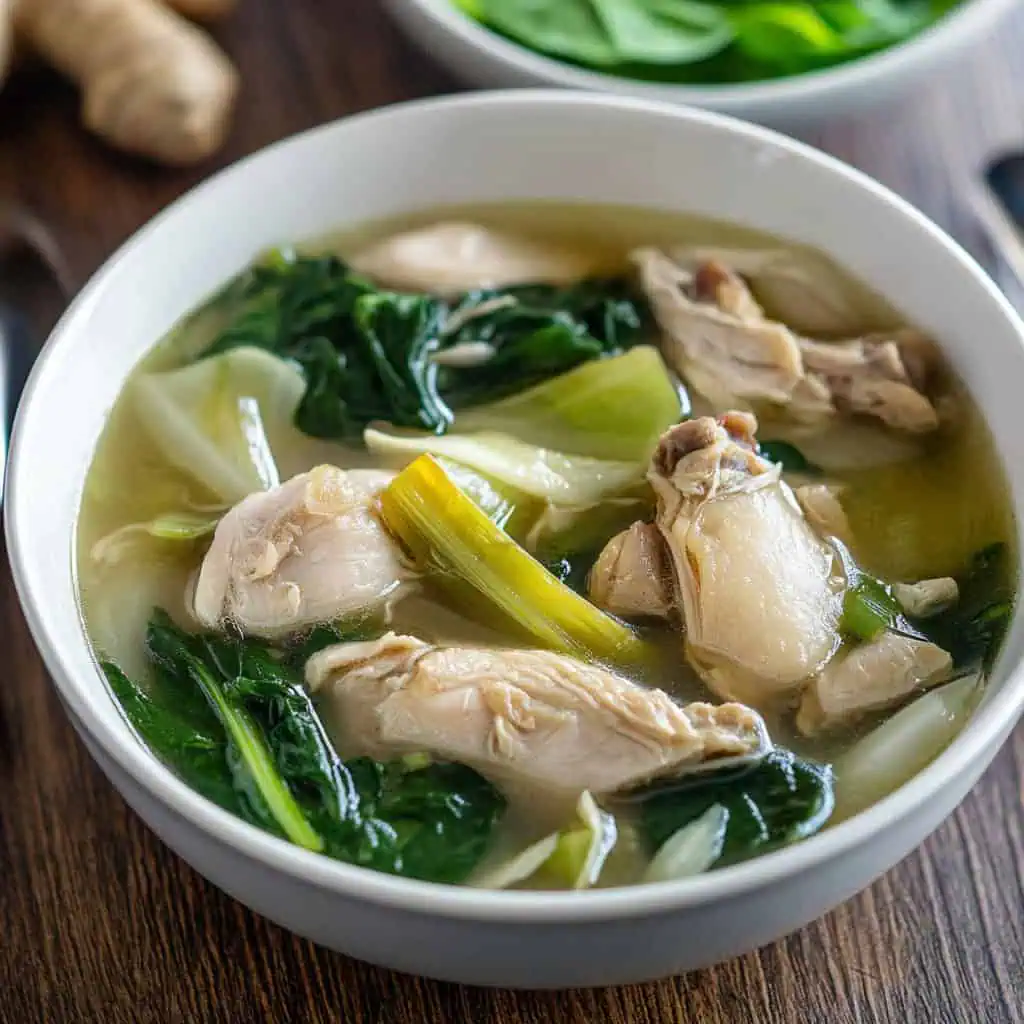
Why You'll Love This Recipe
- 🥥 Unique coconut-based broth that's both refreshing and comforting
- 🌿 Aromatic blend of lemongrass, ginger, and native Filipino ingredients
- 🍗 Tender, fall-off-the-bone chicken pieces
- 🥣 Light yet satisfying - perfect for both sunny and rainy days
- ⏲️ One-pot meal ready in just over an hour
- 👵 Authentic recipe passed down through generations
Ingredients
Native chicken forms the heart of this dish, offering richer flavor than commercial varieties. Coconut water and meat create the signature sweet-savory broth that distinguishes Binakol from other Filipino soups. Lemongrass and ginger provide aromatic depth while offering traditional healing properties.
Green papaya adds subtle sweetness and texture, balancing the protein. Spinach introduces a nutritional boost and vibrant color. Fish sauce delivers that distinctive umami that anchors Filipino cuisine.
Together, these ingredients create a harmonious balance of flavors — sweet, savory, and aromatic - that has made Binakol a beloved comfort food for generations.

For the Soup Base:
- 1 whole native chicken (about 3-4 lbs, cut into serving pieces)
- 4 cups coconut juice
- 1 cup young coconut meat strips
- 2 stalks lemongrass (white parts only)
- 1 thumb-sized ginger, julienned
- 1 medium onion, thinly sliced
- 3 cloves garlic, minced
- 1 tablespoon fish sauce
Vegetables:
- 1 green papaya, peeled and cubed
- 1 bunch spinach, stemmed
- Salt and pepper to taste
- 1 tablespoon cooking oil
Equipment
- Large Heavy-Bottom Pot (Kaldero) - For even heat distribution and slow cooking, ensuring the chicken cooks thoroughly without burning
- Sharp knife and cutting board - For precisely cutting chicken and preparing ingredients to ensure uniform cooking
- Wooden spoon (sandok) - For gentle stirring without scratching the pot and maintaining the integrity of the delicate coconut broth
- Measuring cups and spoons (Panukat) - For accurate measurements to achieve the perfect balance of flavors
- Mortar and pestle (dikdikan) - For crushing lemongrass to release its essential oils and maximize flavor
- Fine-mesh strainer (salaan) - For skimming impurities from the broth to achieve a clear, clean-tasting soup
- Kitchen tongs (Sipit) - For safely handling hot chicken pieces without breaking them apart
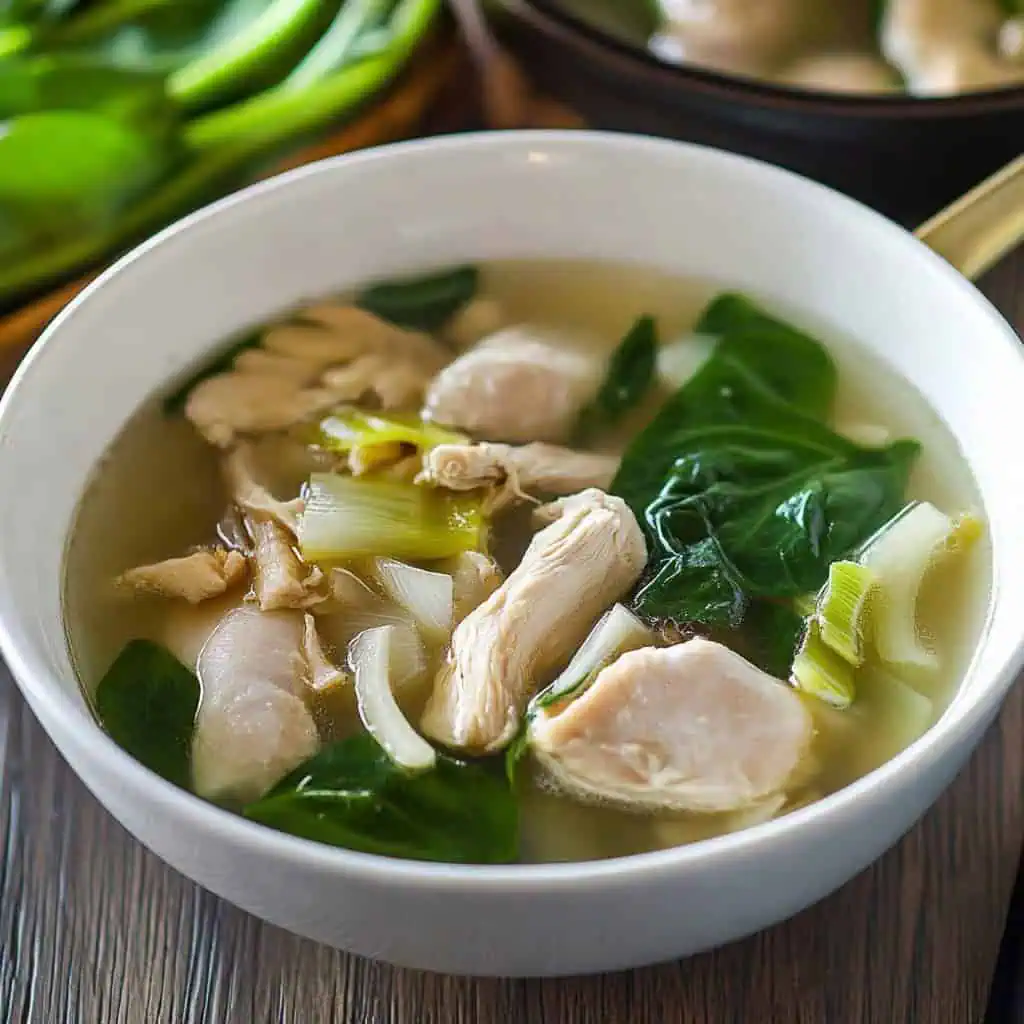
How To Make
- Begin by preparing the aromatics at room temperature: Clean and trim lemongrass stalks, then pound the white parts to release flavors. Julienne the ginger, slice onions thinly, and mince the garlic.
- Heat oil in a large heavy-bottomed pot over medium heat (350°F/175°C). Sauté onions, garlic, and ginger until aromatic, about 2-3 minutes. Add chicken pieces and cook until lightly browned, 5-7 minutes.
- Add fish sauce and cook for 1 minute. Pour in coconut juice and bring to a boil over high heat. Once boiling, reduce heat to low and add lemongrass. Cover and simmer for 25 minutes.
- Reduce heat to low (200°F/95°C). Add papaya chunks and cook for 3-5 minutes until tender but still firm. Add coconut meat strips. Season with salt and pepper to taste.
- Add spinach leaves last and cover the pot. Let the residual heat cook the spinach.
- Let the soup rest for 5 minutes before serving. Serve hot with steamed rice.
- When reheating, ensure the temperature reaches 165°F/74°C internal temperature.

Tips from Lola's Kitchen
- Use native chicken whenever possible for a deeper, more authentic flavor profile
- Bruise the lemongrass thoroughly before adding to release its essential oils
- Simmer on low heat rather than boiling rapidly to keep the chicken tender
- Add coconut meat toward the end to prevent it from becoming too soft
- Season gradually and taste as you go – the coconut water naturally adds sweetness
- Allow the soup to rest for 5-10 minutes before serving to let flavors meld together
- If using regular chicken instead of native, reduce the cooking time by about 10 minutes
Substitutions
- No native chicken? Use regular chicken but add 1 tablespoon chicken bouillon to enhance flavor
- No fresh coconut water? Packaged coconut water works, but reduce to 3 cups and add 1 cup chicken broth
- No green papaya? Substitute with chayote (sayote) or zucchini cut into similar-sized pieces
- No spinach? Use malunggay (moringa) leaves, dahon ng sili (chili leaves), or bok choy
- No fresh lemongrass? Use 2 tablespoons of lemongrass paste or 1 tablespoon dried lemongrass
- Vegetarian option? Replace chicken with firm tofu and use vegetable broth instead of fish sauce
Troubleshooting
- Broth lacks flavor? Add more ginger and lemongrass, or a splash of fish sauce
- Chicken still tough after cooking? Native chicken needs longer cooking – simmer for additional 15-20 minutes
- Soup too watery? Simmer uncovered for 10 minutes to reduce and concentrate flavors
- Too salty? Add more coconut water or a splash of fresh lime juice to balance
- Broth cloudy instead of clear? Skim off any foam that rises to the surface while simmering
- Coconut meat too chewy? Slice it thinner or cook it longer before serving
- Spinach turned brown? Add it only at the very end and use only residual heat to wilt it
Storage & Reheating
- Refrigeration: Store in an airtight container for up to 3 days. The flavors often improve overnight as the aromatics infuse the broth further.
- Freezing: Freeze without the spinach for up to 2 months. Let thaw completely in the refrigerator before reheating.
- Reheating: Warm gently on the stovetop over medium-low heat until the chicken reaches 165°F/74°C internally. Add fresh spinach just before serving.
- Meal prep tip: Prepare the broth and chicken in advance, but add the vegetables fresh when reheating for best texture and color.
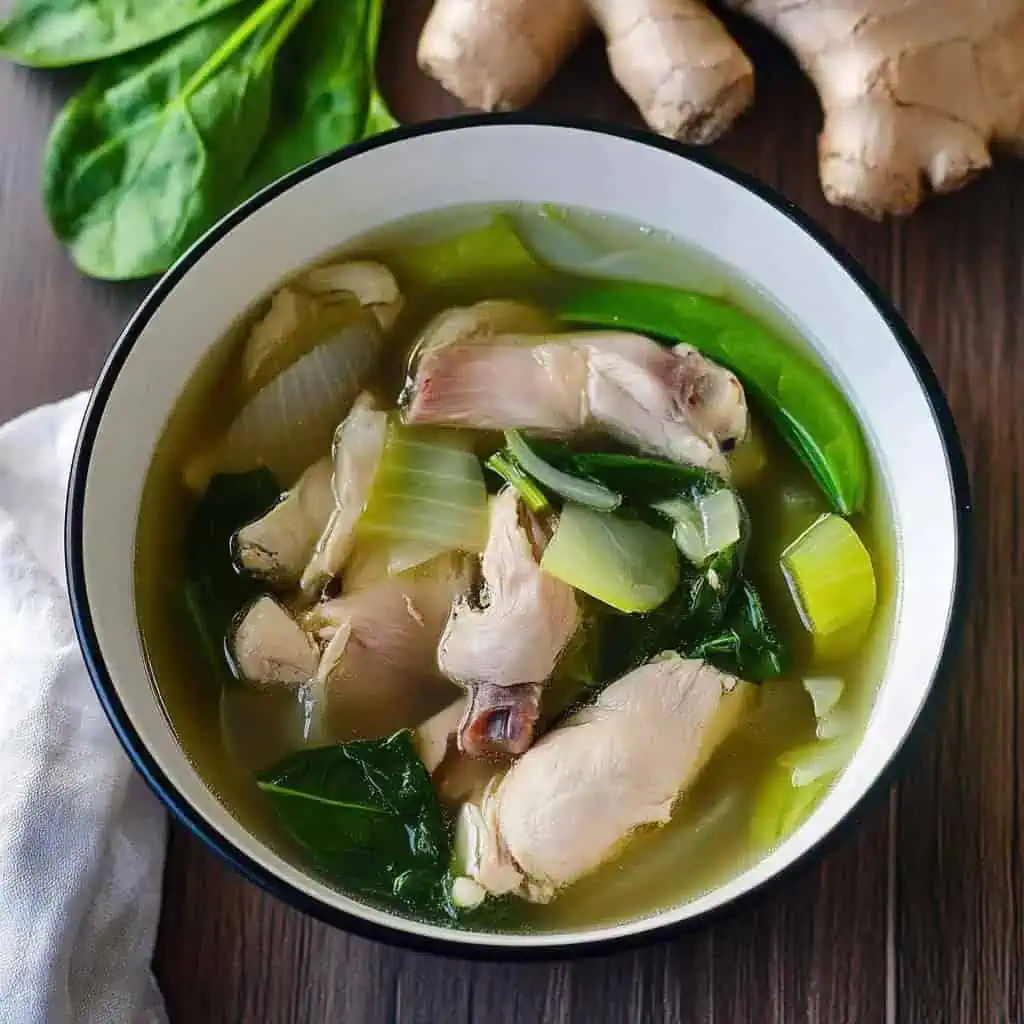
FAQ
What makes Binakol different from Tinola?
Binakol uses coconut water and meat as its base, creating a naturally sweet, nutty broth, while Tinola uses plain water or chicken broth and often includes green papaya and chili leaves.
Can I make this in a slow cooker?
Yes! Cook on low for 6-8 hours or high for 3-4 hours. Add the papaya in the last hour and the spinach just before serving.
Is this recipe good for people with colds?
Absolutely. The combination of ginger, chicken broth, and coconut water makes this a nourishing, comforting meal that's perfect when you're feeling under the weather.
Can I use mature coconut instead of young coconut?
Young coconut meat and water are essential for the authentic flavor. Mature coconut will make the dish too rich and change its character significantly.
How do I select the best coconut for this recipe?
Choose coconuts that feel heavy for their size and slosh with liquid when shaken. For young coconuts, look for ones with soft, jelly-like meat.
Is Binakol traditionally spicy?
No, traditional Binakol isn't spicy, but you can add bird's eye chilies (siling labuyo) if you prefer some heat.
Can I add other vegetables?
Yes! Carrots, corn, and mushrooms make excellent additions while maintaining the dish's character.
What's the best way to serve Binakol?
Serve hot in individual bowls with steamed white rice on the side. Some people like to add a small dish of fish sauce with calamansi for extra flavor.
Related
Looking for other recipes like this? Try these:
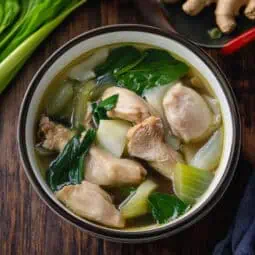
Filipino Chicken Binakol (Binakol na Manok)
Equipment
- Large Heavy-Bottom Pot (Kaldero) For even heat distribution and slow cooking
- Sharp knife and cutting board For preparing ingredients
- Wooden spoon (sandok) For gentle stirring without scratching the pot
- Measuring cups and spoons (Panukat) For accurate measurements
- Mortar and pestle (dikdikan) For crushing lemongrass
- Fine-mesh strainer (salaan) For skimming impurities
- Kitchen tongs (Sipit) For handling hot chicken pieces
Ingredients
For the Soup Base
- 1 whole native chicken manok na native, about 3-4 lbs, cut into serving pieces
- 4 cups coconut juice buko jioce
- 1 cup young coconut meat buko, strips
- 2 stalks lemongrass tanglad, white parts only
- 1 thumb-sized ginger luya, julienned
- 1 medium onion thinly sliced
- 3 cloves garlic bawang, minced
- 1 tablespoon fish sauce patis
Vegetables
- 1 green papaya papaya, peeled and cubed
- 1 bunch spinach stemmed
- Salt and pepper to taste
- 1 tablespoon cooking oil
Instructions
- Begin by preparing the aromatics at room temperature (Ihanda ang mga pampalasa): Clean and trim lemongrass stalks, then pound the white parts to release flavors (Linisin at putulin ang tanglad, at dikdikin ang puting bahagi para lumabas ang lasa). Julienne the ginger, slice onions thinly, and mince the garlic (Hiwaing pahaba ang luya, hiwaing manipis ang sibuyas, at dikdikin ang bawang).
- Heat oil in a large heavy-bottomed pot over medium heat (350°F/175°C). Sauté onions, garlic, and ginger until aromatic, about 2-3 minutes (Igisa ang sibuyas, bawang, at luya). Add chicken pieces and cook until lightly browned, 5-7 minutes (Idagdag ang manok at lutuin hanggang bahagyang kumulay brown).
- Add fish sauce and cook for 1 minute (Idagdag ang patis at lutuin ng isang minuto). Pour in coconut juice and bring to a boil over high heat (Ibuhos ang tubig ng buko at pakuluin). Once boiling, reduce heat to low and add lemongrass (Ibaba ang apoy at idagdag ang tanglad). Cover and simmer for 25 minutes.
- Reduce heat to low (200°F/95°C). Add papaya chunks and cook for 3-5 minutes until tender but still firm (Idagdag ang papaya at lutuin hanggang lumambot pero hindi sobra). Add coconut meat strips (Idagdag ang strips ng buko). Season with salt and pepper to taste (Timplahan ng asin at paminta).
- Add spinach leaves last and cover the pot (Idagdag ang spinach at takpan ang kaldero). Let the residual heat cook the spinach (Hayaang maluto ang spinach sa init ng sabaw).
- Let the soup rest for 5 minutes before serving (Palamiguhin ang sabaw ng 5 minuto bago ihain). Serve hot with steamed rice (Ihain ng mainit kasama ang kanin).
- When reheating, ensure the temperature reaches 165°F/74°C internal temperature (Kapag iinitin, siguraduhing umabot sa 165°F/74°C ang init sa loob ng manok).
Tips from Lola's Kitchen
- Use native chicken (manok na native) for the most authentic flavor
- Crush lemongrass well to release maximum flavor
- Don't overcook the papaya - it should be tender but still hold its shape
- Add spinach last to keep its bright green color
- Let soup rest 5 minutes before serving for flavors to meld
Nutrition
The Story Behind Chicken Binakol (Binakol na Manok)
In the heart of Aklan province, along the sun-kissed shores of Western Visayas, Chicken Binakol emerged as a testament to Filipino culinary ingenuity. This traditional soup, known locally as "Binakol na Manok," represents the indigenous cooking methods of our ancestors, who discovered that cooking chicken in bamboo tubes or fresh coconut shells imparted an extraordinary depth of flavor to the broth.
The name "binakol" comes from the Aklanon word "bakol," which refers to the traditional cooking method of simmering ingredients in coconut water within bamboo nodes. Our ancestors would gather fresh bamboo from the surrounding forests, clean out a section, and use it as a natural cooking vessel. The bamboo itself would infuse the dish with subtle, earthy notes that perfectly complemented the sweet coconut water and tender chicken.
What sets Binakol apart from its cousin, the more widely known Tinola, is its distinctive use of coconut water and young coconut meat. While both dishes share similar aromatics like ginger and lemongrass (tanglad), Binakol's coconut-based broth creates a uniquely refreshing yet deeply satisfying flavor profile that has been cherished for generations. Local healers, or albularyo, also believed in its restorative properties, often recommending it to those recovering from illness.
Today, while most home cooks prepare Binakol in standard pots rather than bamboo tubes, the essence of this dish remains unchanged. It continues to be a beloved comfort food throughout the Philippines, particularly during the rainy season or when family members are feeling under the weather. The combination of native chicken, coconut, and aromatic herbs creates a bowl of soup that's not just nourishing for the body but also warming for the soul.
Many Filipino families now consider Binakol their go-to comfort soup, adapting the recipe to their own tastes while maintaining its core elements. Whether served in a humble home kitchen or featured in upscale Filipino restaurants, this dish represents the enduring legacy of our culinary heritage and the timeless appeal of simple, wholesome cooking.








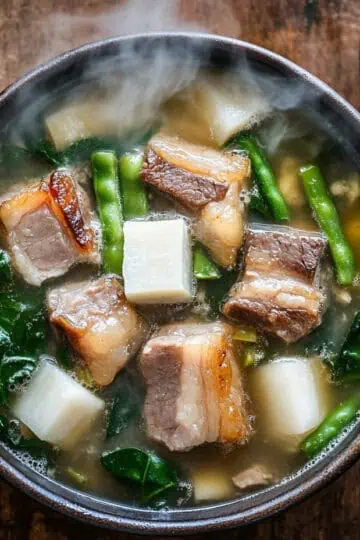
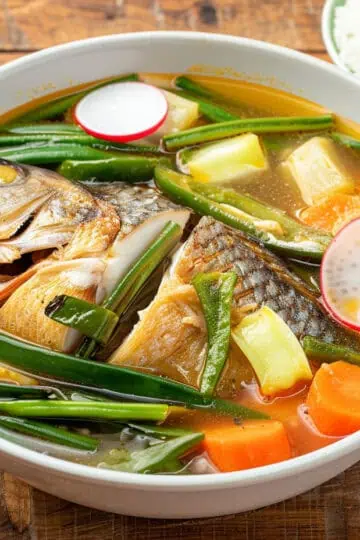
Comments
No Comments